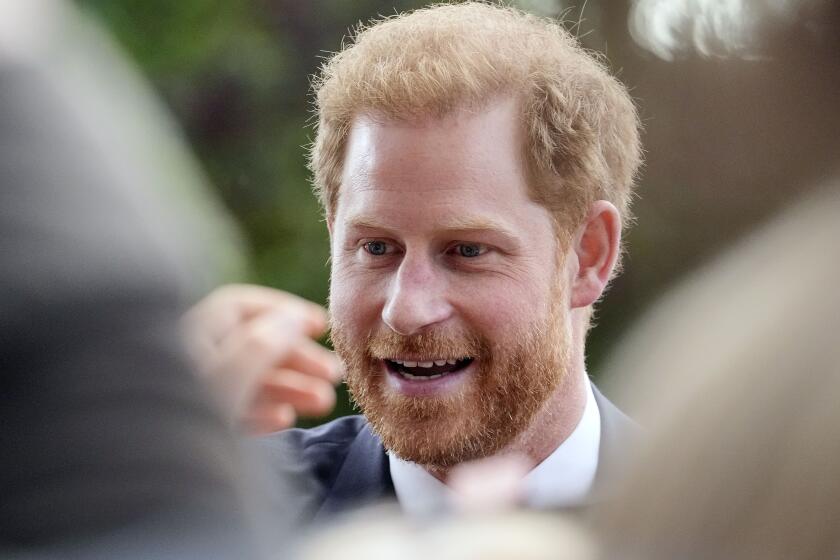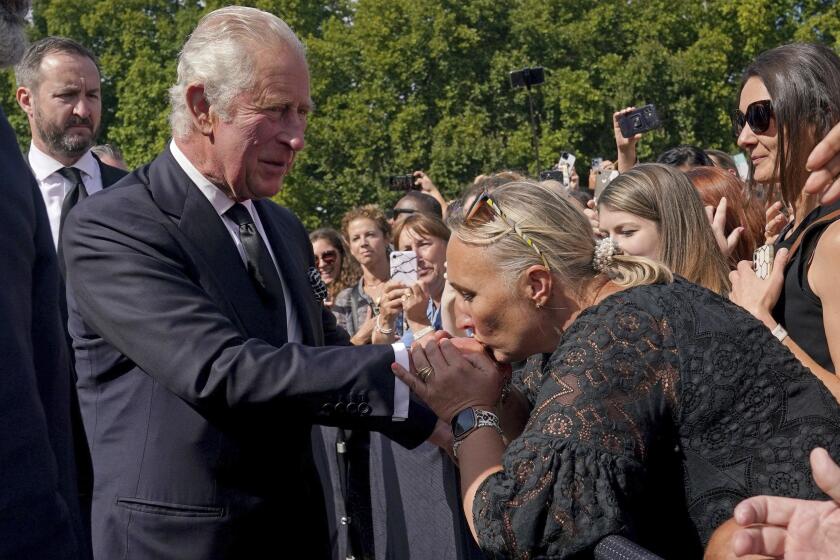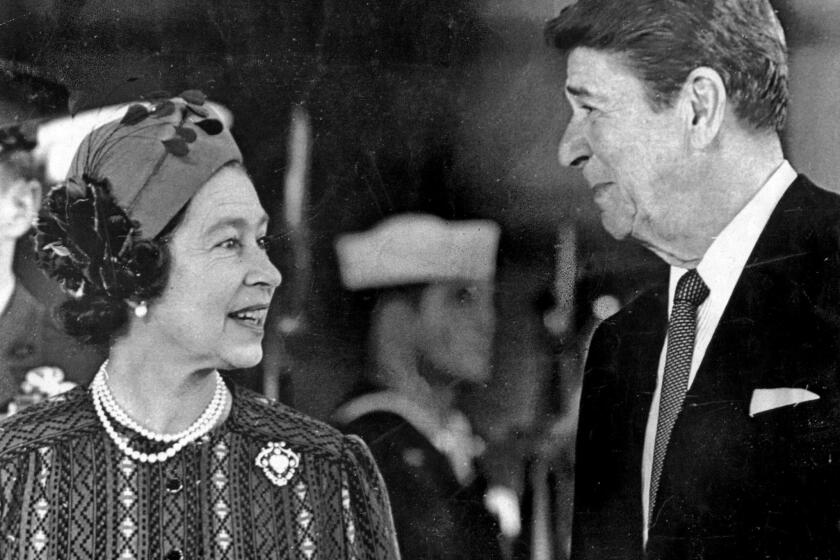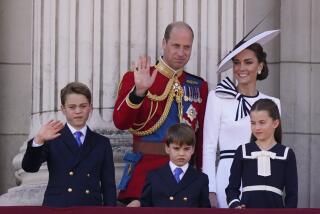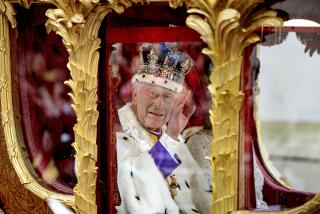Casket of Queen Elizabeth II arrives at Buckingham Palace
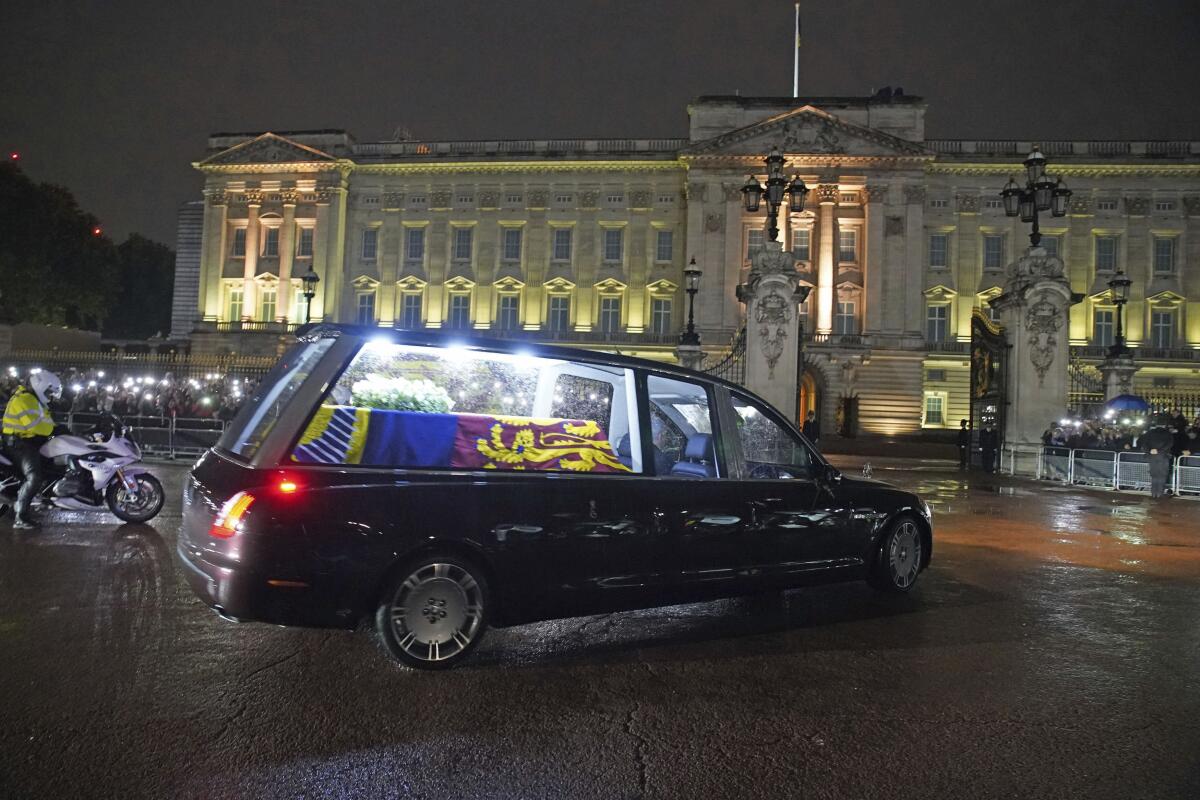
- Share via
LONDON — The coffin of Queen Elizabeth II returned to Buckingham Palace on Tuesday evening, making its way through a drizzly London as crowds lined the route for a glimpse of the hearse and to bid her a final farewell.
People parked their cars along a normally busy road, got out and waved as the hearse, with lights inside illuminating the flag-draped coffin, made its way into London. In the city, people pressed in on the road and held their phones aloft as it passed.
Thousands outside the palace cheered, shouted, “God save the queen!” and clapped as the hearse swung around a roundabout in front of the queen’s official London residence and through the wrought iron gates. Her son, King Charles III, and other immediate family members waited inside.
The coffin traveled to London from Edinburgh, Scotland, where 33,000 people filed silently past it in the 24 hours at St. Giles’ Cathedral after it had been brought there from her cherished summer retreat, Balmoral. The queen — the only monarch many in the United Kingdom have ever known — died there Sept. 8 at age 96 after 70 years on the throne.
The military C-17 Globemaster carrying the casket touched down at RAF Northolt, an air force base in the west of London, about an hour after it left Edinburgh. U.K. Prime Minister Liz Truss, Defense Secretary Ben Wallace and a military honor guard were among those at the base for the arrival.
One who stood in the rain waiting for the hearse to pass, retired bus driver David Stringer, 82, recalled watching the queen’s coronation on a newsreel as a boy.
“It’s a great shame,” he said. “I mean, I didn’t think about her every day, but I always knew she was there, and my life’s coming to a close now and her time has finished.”
‘Her unwavering grace and dignity remained true throughout her life and now her everlasting legacy,’ Prince Harry said after the death of the queen.
The coffin will be taken by horse-drawn gun carriage Wednesday to the Houses of Parliament to lie in state for four days before Monday’s funeral at Westminster Abbey.
“Scotland has now bid our Queen of Scots a sad, but fond farewell,” said Scottish First Minister Nicola Sturgeon. “We will not see her like again.”
Charles had returned to London from Northern Ireland, where his visit drew a rare moment of unity from politicians in a region with a contested British and Irish identity that is deeply divided over the monarchy.
The new king is making his own journey this week, visiting the four nations of the U.K.: England, Scotland, Wales and Northern Ireland.
Hundreds gathered around Hillsborough Castle near Belfast, the royal family’s official residence in Northern Ireland, in the latest outpouring of affection following the queen’s death. The area in front of the gates to the castle was carpeted with hundreds of floral tributes.
Charles and his wife, Camilla, the queen consort, got out of their car to wave to the crowd and sometimes used both hands to reach out to villagers, including schoolchildren in bright blue uniforms. Charles even petted a corgi — famously his late mother’s favorite breed of dog — held up by one person, and some chanted, “God save the king!”
A rising tide of anti-royal sentiment thrusts a British throne without Queen Elizabeth into unstable territory.
“Today means so much to me and my family. Just to be present in my home village with my children to witness the arrival of the new king is a truly historic moment for us all,” said Hillsborough resident Robin Campbell.
He added that it was “also a day tinged with great sadness as we witness a loving son coming to our village while we are all in mourning for the loss of a truly magnificent queen and his loving mother.”
While there was a warm welcome in Hillsborough, the British monarchy draws mixed emotions in Northern Ireland, where there are two main communities: mostly Protestant unionists who consider themselves British and largely Roman Catholic nationalists who see themselves as Irish.
That split fueled three decades of violence known as “the Troubles” involving paramilitary groups on both sides and British security forces; about 3,600 people died in the conflict. The royal family was touched personally by the violence: Lord Louis Mountbatten, a cousin of the queen and a much-loved mentor to Charles, was killed by an Irish Republican Army bomb in 1979.
A deep sectarian divide remains nearly 25 years after Northern Ireland’s 1998 peace agreement.
For some Irish nationalists, the British monarch represents an oppressive foreign power. But others acknowledge the queen’s role in forging peace. On a visit to Northern Ireland in 2012, she shook hands with Sinn Fein deputy leader Martin McGuinness, a former IRA commander — a once-unthinkable moment of reconciliation. On Tuesday the new king shook hands with Sinn Fein Vice President Michelle O’Neill.
Queen Elizabeth II’s 1983 trip to California didn’t turn out as she had expected, columnist George Skelton writes, and then-Prince Charles’ visit undoubtedly caught him by surprise.
In a sign of how far Northern Ireland has come on the road to peace, representatives of Sinn Fein attended commemorative events for the queen and meeting the king Tuesday.
Alex Maskey, a Sinn Fein politician who is speaker of the Northern Ireland Assembly, said the queen’s example had helped “break down barriers and encourage reconciliation.”
Charles responded that his mother had tried to play a role “in bringing together those whom history had separated, and in extending a hand to make possible the healing of long-held hurts.”
He said he would draw on his mother’s “shining example” and “seek the welfare of all the inhabitants of Northern Ireland.”
Still, not everyone was welcoming the new king.
Breaking News
Get breaking news, investigations, analysis and more signature journalism from the Los Angeles Times in your inbox.
You may occasionally receive promotional content from the Los Angeles Times.
On the Falls Road in Belfast, a nationalist stronghold, several walls are decorated with murals of Bobby Sands, an IRA member who died while on a hunger strike in prison in 1981, and others killed in the Troubles.
“No, he’s not our king. Bobby Sands was our king here,” said 52-year-old Bobby Jones. “Queen never done nothing for us. Never did. None of the royals do.”
Irish leaders attended a service of reflection at St. Anne’s Cathedral in Belfast, despite tense relations between Dublin and London over Brexit. Since Britain left the European Union in 2020, the Britain and the EU have been wrangling over trade rules for Northern Ireland, the only part of the U.K. that shares a border with a member of the 27-nation bloc.
Before being flown to London, the queen’s oak coffin was carried from St. Giles’ Cathedral to the strain of bagpipes. Crowds lining the Royal Mile through the historic heart of Edinburgh broke into applause as the coffin, accompanied by the queen’s daughter, Princess Anne, was driven to Edinburgh Airport.
“I was fortunate to share the last 24 hours of my dearest mother’s life,” Anne said in a statement. “It has been an honour and a privilege to accompany her on her final journeys. Witnessing the love and respect shown by so many on these journeys has been both humbling and uplifting.”
More to Read
Sign up for Essential California
The most important California stories and recommendations in your inbox every morning.
You may occasionally receive promotional content from the Los Angeles Times.
